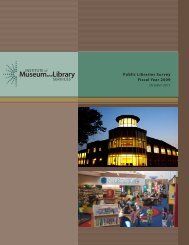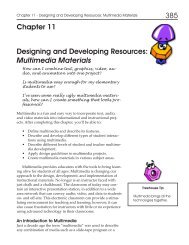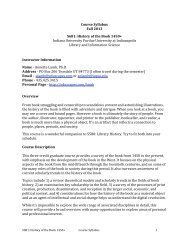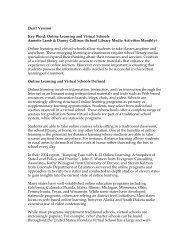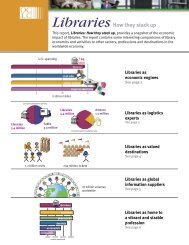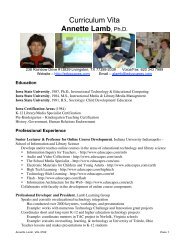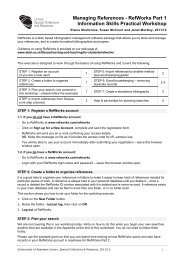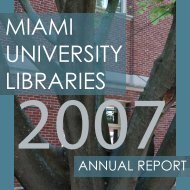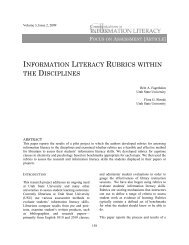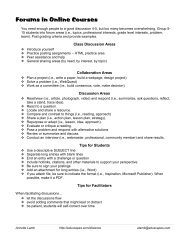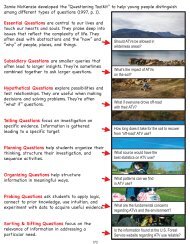Therapy Dogs Provide Stress (and Comic) Relief - eduScapes
Therapy Dogs Provide Stress (and Comic) Relief - eduScapes
Therapy Dogs Provide Stress (and Comic) Relief - eduScapes
Create successful ePaper yourself
Turn your PDF publications into a flip-book with our unique Google optimized e-Paper software.
COMFORT • HEALING • MOTIVATION • STRESS RELIEF • THERAPY • COMFORT • HEALING • MOTIVATION • STRESS RELIEF •<br />
Monk, the Saint Bernard, makes<br />
himself comfortable in the lap of law<br />
student Joanna Weil LiCalsi during a<br />
therapy dog session.<br />
Photo by University of San Francisco, Zief Law<br />
Library Research Librarian John Shafer<br />
DOGS PROVIDE STRESS<br />
(AND COMIC) RELIEF<br />
USF students discover something<br />
even more rewarding than<br />
poring over the law<br />
By Suzanne Mawhinney<br />
Pit bull/weimaraner mix, Sophia Loren, poses for<br />
the camera during a therapy dog session.<br />
Photo by University of San Francisco Gleeson Library’s Head of<br />
Access Services <strong>and</strong> Facilities Shawn P. Calhoun<br />
6 AALL Spectrum ■ November 2011 © 2011 Suzanne Mawhinney<br />
After reading about Monty, a dog<br />
owned by a Yale law librarian who<br />
was “circulated” among students to<br />
help them deal with the stress of their legal<br />
studies, the University of San Francisco Law<br />
School wanted to establish a similar program<br />
to help our students during their exam<br />
period. There were just a few issues to work<br />
out first, such as where to find such a dog <strong>and</strong><br />
how to ensure the dog’s comfort <strong>and</strong> safety<br />
while on duty at the library.
• COMFORT • HEALING • MOTIVATION • STRESS RELIEF • THERAPY • COMFORT • HEALING • MOTIVATION • STRESS RELIEF •<br />
We contacted the San Francisco<br />
Society for the Prevention of Cruelty<br />
to Animals whose Animal Assisted<br />
<strong>Therapy</strong> Program (AAT) is “designed to<br />
facilitate communication, healing, <strong>and</strong><br />
motivation” between companion animals<br />
<strong>and</strong> people facing various challenges in<br />
their lives. However, because the AAT<br />
program usually sends its volunteer<br />
teams—consisting of a dog <strong>and</strong> its<br />
human companion—to medical or<br />
convalescent facilities, we did not know<br />
if AAT would be willing to work with<br />
us. Fortunately, they were open to the<br />
idea.<br />
Setting Up the Program<br />
After getting the appropriate approvals<br />
from university administrators, an<br />
AAT representative came to inspect our<br />
library to make sure that we met its<br />
safety st<strong>and</strong>ards for host facilities. After<br />
we passed AAT’s inspection, the program<br />
provided us with written doggie<br />
“credentials” verifying that each of the<br />
five dogs coming to our library had<br />
obtained the training, temperament<br />
testing, <strong>and</strong> health certifications required<br />
for all dogs in the program.<br />
Next we set out to find an<br />
appropriate space to hold our therapy<br />
sessions. We wanted to make sure that<br />
anyone who did not wish to be around<br />
the dogs—those who were fearful or<br />
allergic, for example—would not have<br />
to be. We decided on our student TV<br />
lounge, which we made as comfortable<br />
for the dogs as possible. It was set up<br />
with a doggie bed <strong>and</strong> water bowl, <strong>and</strong><br />
each of the dogs’ owners brought his or<br />
her dog’s favorite treats or toys.<br />
After we advertised the therapy dog<br />
program to students in our weekly law<br />
school community email, blog, <strong>and</strong><br />
Twitter feeds, the sign-up sheets filled up<br />
so quickly that we decided to add a few<br />
extra sessions. We also invited our faculty<br />
<strong>and</strong> staff to participate. Before we knew<br />
it, we had scheduled the dogs to visit<br />
twice a day for four days during a twoweek<br />
period. Each session was to last<br />
for 10 minutes, <strong>and</strong> participants could<br />
schedule a session for themselves alone<br />
or with a friend or two.<br />
The <strong>Dogs</strong> Arrive<br />
Our first canine therapist was a pit<br />
bull/Weimaraner mix named Sophia<br />
Loren who had the trademark wiggly<br />
hind end <strong>and</strong> people-friendly nature of<br />
a pit bull <strong>and</strong> the blue-grey coloring of a<br />
Weimaraner. Although she was happy to<br />
do tricks, she was very calm <strong>and</strong> content<br />
to lie on her side while her visitors gave<br />
her belly rubs <strong>and</strong> chatted with her<br />
human companion about the benefits of<br />
the AAT program. Sophia, along with a<br />
Labrador retriever named Daphne <strong>and</strong> a<br />
golden retriever named Blaise, were the<br />
perfect therapy dogs for those looking<br />
for a calm, quiet encounter.<br />
For anyone wanting a livelier<br />
adventure, MotC, a Labrador<br />
retriever/poodle mix, fit the bill.<br />
MotC was a soft <strong>and</strong> fluffy puppy, full<br />
of bounce <strong>and</strong> eager to perform tricks<br />
in exchange for treats. Her silly antics<br />
provided just the comic relief many<br />
students were looking for.<br />
Our last canine therapist was a<br />
150-pound Saint Bernard named Monk,<br />
whose size <strong>and</strong> massive amounts of<br />
shedding were only to be outdone by<br />
his copious drooling <strong>and</strong> big droopy<br />
eyes. Sessions with Monk were<br />
not for the excessively fastidious,<br />
however; I left my session with<br />
him covered in hair <strong>and</strong> slobber<br />
(<strong>and</strong> a big smile). Monk was a<br />
crowd favorite.<br />
Word of our program spread<br />
to the local community, <strong>and</strong><br />
several of the therapy sessions<br />
were documented by members<br />
of the local print, television, <strong>and</strong><br />
radio media. The program was<br />
so popular, in fact, that in a few<br />
instances there were more<br />
AALL Spectrum ■ November 2011 7
After we advertised the therapy dog program to students in our weekly law school community email, blog,<br />
<strong>and</strong> Twitter feeds, the sign-up sheets filled up so quickly that we decided to add a few extra sessions.<br />
reporters in the room than students,<br />
faculty, or staff. We hope that all of<br />
the media attention had the effect<br />
of humanizing legal studies for the<br />
students <strong>and</strong> in the eyes of the local<br />
community.<br />
Lessons Learned<br />
We also hope to make our dog<br />
therapy program a regular part of<br />
the exam period in future semesters<br />
with just a few changes to avoid<br />
some mistakes we made the first time<br />
around.<br />
For other libraries hoping to<br />
follow in our footsteps, I offer just<br />
a few tips to ensure that things go<br />
smoothly for you <strong>and</strong> the dogs. First,<br />
be sure to remind participants of their<br />
appointments a day or two in advance<br />
to prevent no-shows. Also, allow<br />
enough time for the volunteer teams<br />
to arrive <strong>and</strong> get set up before the first<br />
appointment of the day so that the<br />
students, whose schedules are already<br />
tightly packed with exams <strong>and</strong> study<br />
sessions, can count on their sessions<br />
beginning on time.<br />
Don’t forget that the students’<br />
experience is paramount—check with<br />
students before inviting reporters to<br />
attend a session or schedule special<br />
sessions just for media. Finally, don’t<br />
forget that some people don’t wish to<br />
be around dogs. Plan ahead <strong>and</strong> pick<br />
an appropriate location, <strong>and</strong> be sure<br />
to have the room thoroughly cleaned<br />
after the therapy sessions so that those<br />
with allergies can use the space<br />
without fear of a reaction.<br />
Overall, we feel confident that<br />
we achieved our goal of providing a<br />
little levity <strong>and</strong> stress relief at a very<br />
stressful time. Christy Siojo, a thirdyear<br />
student who was lucky enough<br />
to score two sessions with the therapy<br />
dogs, seems to agree. She says how<br />
amazing it was that she was<br />
quickly “able to forget<br />
about the stress<br />
of finals<br />
<strong>and</strong><br />
papers by just spending a little time<br />
with the dogs … it’s little things like<br />
that that can reinvigorate you <strong>and</strong><br />
help you to study better.”<br />
As librarians <strong>and</strong> educators<br />
dedicated to providing an optimal<br />
learning environment for our<br />
students, we were thrilled that we had<br />
the opportunity to do something so<br />
positive <strong>and</strong> uplifting for them. ■<br />
Suzanne Mawhinney (skmaw<br />
hinney@usfca.edu) is a research librarian<br />
at Zief Law Library at the University<br />
of San Francisco School of Law.<br />
MotC, the Labrador retriever/poodle mix, visits with Law Library Director<br />
Ron Wheeler during a therapy dog session.<br />
Photo by University of San Francisco, Zief Law Library Research Librarian John Shafer<br />
Editor’s note: read more about<br />
Monty <strong>and</strong> see his photo at www.npr.<br />
org/2011/03/31/135011159/montythe-dog-hits-the-stacks-at-yale-law.<br />
Read<br />
more about the San Francisco Society<br />
for the Prevention of Cruelty to<br />
Animals’ Animal Assisted <strong>Therapy</strong><br />
Program at www.sfspca.org/programsservices/animal-assisted-therapy.<br />
8<br />
AALL Spectrum ■ November 2011



